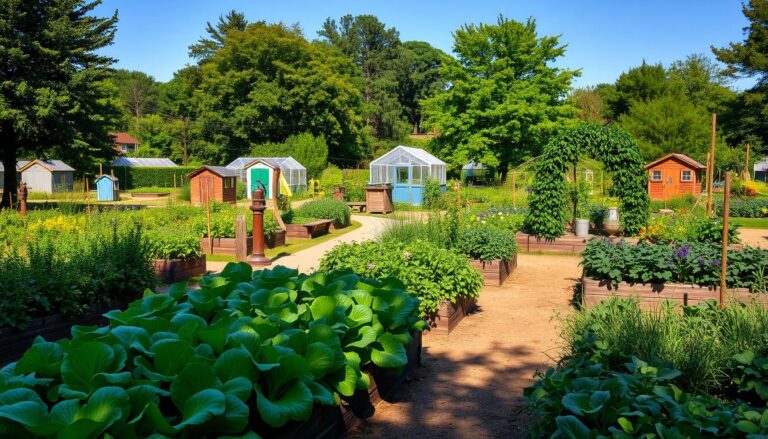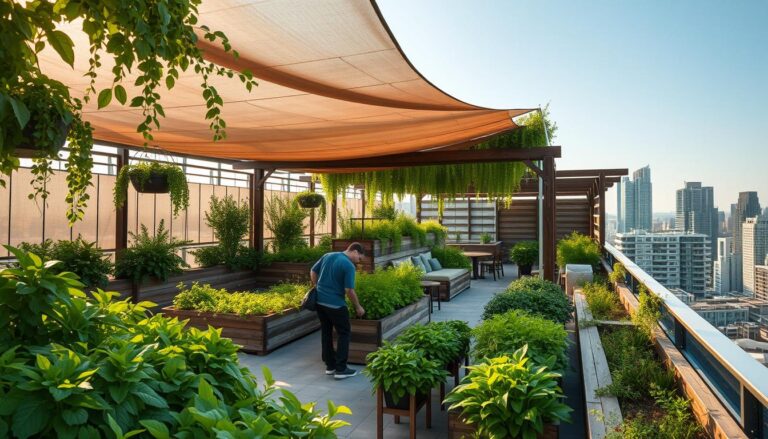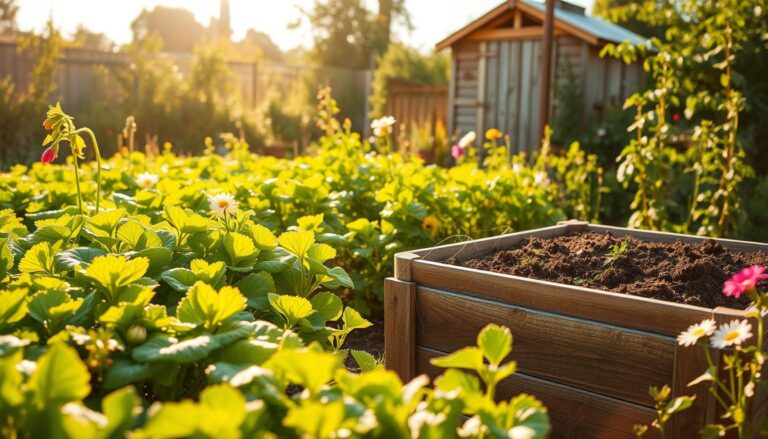Gardening is a rewarding hobby that connects you with nature. It also lets you grow your own healthy, chemical-free food. Embracing organic gardening means using a sustainable and eco-friendly way to grow your garden.
If you’re new to gardening, a beginner’s guide to organic gardening is key. It teaches you about soil health, composting, and natural pest control. By following a step-by-step guide, you can grow a thriving organic garden.
Starting your journey in how to cultivate an organic garden means learning its benefits and importance. It’s about making a balanced ecosystem that supports you and the environment.
Understanding Organic Gardening Principles
Starting with organic gardening principles is key to a sustainable and healthy garden. Organic gardening uses natural methods to keep soil quality high, save water, and support many different plants.
What Makes a Garden “Organic”
An organic garden avoids synthetic fertilizers, pesticides, and GMOs. Organic gardening tips suggest using compost, manure, and green manure to improve soil. It also involves rotating crops and planting them together to fight pests and diseases.
Benefits of Growing Your Own Organic Produce
Growing your own organic food is great for many reasons. You get to eat fresh, healthy food, help the environment, and save money. By using sustainable gardening practices, you also help the ecosystem and support biodiversity.
Common Misconceptions About Organic Gardening
Some think organic gardening is too hard or doesn’t produce much. But, with the right methods, organic gardens can be as productive as others. Learning the basics of organic gardening can clear up these myths and make it easier to start.
How to Start an Organic Garden: Planning Phase
Before you plant your first seed, planning is key. This step is vital for a successful garden. Starting a garden from scratch might seem tough, but with a good plan, organic gardening for beginners is fun and easy.
Assessing Your Space and Climate
First, check your space and climate. This helps you choose the right garden and plants.
Container vs. In-Ground Gardens
Choose between container or in-ground gardens. Containers are great for small spaces, while in-grounds offer more room for roots.
Understanding Your Hardiness Zone
It’s important to know your hardiness zone. This helps pick plants that will do well in your area. The USDA Plant Hardiness Zone Map is a good tool for this.
Selecting the Right Location for Maximum Sunlight
Most plants need at least 6 hours of sunlight a day. Watch your garden’s sunlight to find the best spot for your plants.
Deciding What to Grow Based on Your Region
Pick plants that fit your climate and soil. Local nurseries and gardening clubs can offer great advice.
Creating a Garden Layout
A good layout uses space well and helps plants grow healthy. Think about how big plants will get and how far apart they should be.
Companion Planting Basics
Companion planting means growing different plants together. For example, marigolds with tomatoes can keep nematodes away.
“Companion planting is a simple, effective way to create a balanced and diverse garden ecosystem.”
Preparing Your Garden Soil Naturally
The foundation of a thriving organic garden lies in its soil. Preparing your garden soil naturally is a crucial step in growing organic vegetables and maintaining an eco-friendly gardening practice.
Testing Your Soil Composition
Before you start amending your soil, it’s essential to understand its composition. Testing your soil will reveal its pH level and nutrient content, helping you make informed decisions about how to improve it.
Building Healthy Soil Without Chemicals
Building healthy soil without chemicals involves using natural methods to enhance its structure and fertility. One effective method is no-till gardening, which minimizes soil disturbance.
No-Till Gardening Methods
No-till gardening methods reduce soil erosion and preserve soil organisms. This approach involves layering organic materials like compost and mulch to create a nutrient-rich soil environment.
Making and Using Compost
Compost is a vital component of organic gardening. It adds nutrients, improves soil structure, and supports beneficial microbial activity.
Setting Up a Compost System
To set up a compost system, start by selecting a location for your compost pile or bin. Include a mix of ‘green’ materials (like kitchen scraps) and ‘brown’ materials (like dried leaves).
Natural Soil Amendments for Different Soil Types
Different soils require different amendments. For example, clay soils benefit from organic matter like compost, while sandy soils may need additional organic matter to retain moisture.
| Soil Type | Amendment | Benefit |
|---|---|---|
| Clay | Compost | Improves drainage |
| Sandy | Organic matter | Retains moisture |
| Loamy | Manure | Adds nutrients |
Selecting and Starting Organic Seeds
To grow a healthy organic garden, starting seeds the right way is key. This means picking the best seeds and learning how to plant them.
Choosing Organic and Heirloom Varieties
For organic gardening for beginners, picking the right seeds is important. Go for organic and heirloom seeds. They make your garden chemical-free and full of variety. Heirloom seeds also bring unique tastes and textures to your garden.
Starting Seeds Indoors vs. Direct Sowing
Whether to start seeds indoors or directly in the garden depends on the plant and the weather. Some plants do better indoors, while others grow better outside.
DIY Seed Starting Equipment
For new organic gardeners, making your own seed starting tools is fun and saves money. You can use things like egg cartons and yogurt cups to make mini greenhouses.
| Seed Type | Starting Method | Benefits |
|---|---|---|
| Tomatoes | Indoor Starting | Gives a head start on the growing season |
| Carrots | Direct Sowing | Avoids transplant shock |
| Lettuce | Direct Sowing | Quick germination and growth |
Creating an Organic Seed Starting Mix
A good seed starting mix is essential for healthy seedlings. Mix peat moss, vermiculite, and perlite. Make sure it’s free from harmful chemicals and pesticides.
Hardening Off Seedlings Before Transplanting
Before moving seedlings to your organic garden, harden them off first. Slowly get them used to outdoor conditions over 7-10 days. This helps prevent shock.
Natural Pest Management Strategies
Keeping an organic garden healthy means using a whole approach to pest control. This is especially true when you don’t want to use chemical pesticides. It’s key to keep your garden healthy and productive.
Identifying Common Garden Pests
The first step is to know what pests you have. Common pests are aphids, slugs, snails, caterpillars, and beetles. Knowing what pests you face helps you pick the best ways to control them.
Companion Planting for Pest Control
Companion planting is a simple way to control pests. Some plants can keep pests away or attract good bugs. For instance, marigolds with tomatoes can keep nematodes away.
| Companion Plant | Pest Controlled |
|---|---|
| Marigold | Nematodes |
| Basil | Aphids, Whiteflies |
| Garlic | Aphids, Spider Mites |
Making Homemade Organic Pest Deterrents
Homemade pest solutions are cheap and good for the planet. Two good recipes are essential oil sprays and garlic and hot pepper mixtures.
Essential Oil Sprays
Peppermint and lemongrass oils can keep pests away. Just mix a few drops with water and spray it on your plants.
Garlic and Hot Pepper Solutions
Garlic and hot peppers can also repel pests. Mix them with water, strain, and spray on your plants.
Attracting Beneficial Insects to Your Garden
Bringing in good bugs is a big part of natural pest control. Bugs like ladybugs and lacewings eat pests.
Creating Insect Habitats
To get these good bugs, make a welcoming space for them. Plant different flowers and herbs that attract them.
Using these natural methods, you can keep your organic garden safe from pests. This way, your garden stays healthy and balanced.
Sustainable Watering and Maintenance Practices
To keep your organic garden thriving, use sustainable watering and maintenance. This means using efficient watering, mulching, and feeding methods. It also includes harvesting at the right time.
Water Conservation Techniques
Water conservation is key for a sustainable garden. Two effective ways to save water are:
- Implementing efficient irrigation systems
- Harvesting rainwater
Drip Irrigation Systems
Drip irrigation sends water straight to the roots. This cuts down on evaporation and runoff. It’s especially good in dry areas, as it makes sure plants get the water they need without waste.
Rainwater Harvesting
Rainwater harvesting is another great way to save water. By catching rain in barrels or tanks, you can use it later. This reduces your need for city water and lowers your water bills.
Mulching Methods for Moisture Retention
Mulching helps keep soil moist. By putting organic mulch around plants, you keep the soil cool and moist. This stops moisture from evaporating.
As Alan Chadwick said, “Mulching is a key to maintaining soil health and reducing the need for frequent watering.” It saves water, stops weeds, and keeps soil temperature steady.
Organic Feeding Throughout the Growing Season
Feeding plants organically is crucial for their health. Use compost, manure, or other organic fertilizers. These provide the nutrients plants need to grow well.
- Compost tea
- Fish emulsion
- Manure
Harvesting and Succession Planting
Succession planting and timely harvesting boost garden productivity. Succession planting means planting small batches of seeds often. This keeps your garden producing throughout the season.
Seasonal Maintenance Calendar
Keeping a seasonal maintenance calendar helps you stay on track. It guides you through seasonal tasks, like preparing for winter or managing pests in summer.
- Spring: Prepare soil, plant seeds
- Summer: Maintain mulch, monitor for pests
- Fall: Harvest, clean up garden
- Winter: Plan for next season, protect soil
Conclusion: Enjoying the Fruits of Your Organic Garden
Now that you’ve finished this guide, you’re all set to start or keep growing your organic garden. You’ve learned how to plan, prepare, and care for a healthy garden. This guide has shown you the way.
It’s time to enjoy what you’ve worked for. Taste the fresh produce you’ve grown. Organic gardening is good for the planet and your health. Keep learning and share your gardening adventures with others.
Starting a garden takes time, effort, and practice. But the joy and rewards are huge. You’re on your way to a garden full of fresh food for years.
FAQ
What is organic gardening, and how does it differ from traditional gardening?
How do I start an organic garden from scratch?
What are some eco-friendly gardening techniques for pest control?
How can I improve my soil’s health without using chemicals?
What are the benefits of using compost in my organic garden?
How often should I water my organic garden, and what are some water conservation techniques?
Can I grow organic vegetables in containers, or do I need an in-ground garden?
How do I harden off seedlings before transplanting them into my garden?

Sortemdia nasceu com o propósito de trazer alegria e oportunidades para todos por meio de sorteios gratuitos de prêmios incríveis. O site tem como missão oferecer experiências acessíveis, divertidas e justas para quem deseja concorrer a produtos, serviços e brindes sem pagar nada por isso. Acreditamos que a sorte pode bater à porta de qualquer pessoa — e no Sortemdia, ela pode chegar com apenas um clique.



